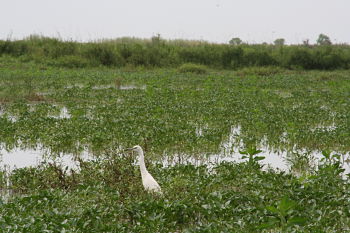

Louisiana wetlands are disappearing and the oil spill has heightened the problem by soiling additional habitat. With each acre lost, waterfowl and other birds lose a valuable food resource but flooding fallow rice fields, like this one in Vermilion Parish, can provide alternative habitat and food. (Photo by Justin Nobel/Audubon Magazine)
Gueydan, Louisiana, July 30
This is duck country. There is a duck welcome sign, a duck car wash and in September a duck festival that features duck dashes, duck decoy carving and a duck calling contest. Farmers can make an extra $50,000 a year renting out their fields to duck hunters. So what the duck am I doing here, a dozen miles from the coast and more than 200 miles from the Deepwater Horizon oil spill site? Because with oil still in the Gulf and millions of migrant birds headed this way, these fields may provide an important alternative habitat.
“In a worst case scenario oil gets into the intermediary marshes and reduces the amount of food for migrating birds,” says Bob Dew, a conservation programs manager for Ducks Unlimited. “I don’t think we can shortstop birds coming to the coast, they will come regardless, but we can put as much good quality habitat out there as possible.”
Each fall, birds funnel through Louisiana from points north but the wetlands they rely on for food are disappearing—dams and dikes have blocked the silt that replenishes wetlands and oil and gas companies have sliced up the marsh to clear canals and make room for wellheads. The oil spill has heightened the problem by soiling additional habitat. Ducks like blue-winged teals and mallards winter in wetlands while shorebirds like dowitchers and sandpipers stop off on their way to the coast. For over a decade, Ducks Unlimited has been providing Texas and Louisiana farmers with water structure equipment so they can flood their fallow fields to create bird habitat. A recent project in light of the oil spill aims to get additional farmers in southwest Louisiana involved.
To learn more I meet up with Ducks Unlimited biologist Robbie Howard on a country lane in Vermilion Parish beside the Intracoastal Waterway, a sheltered shipping channel that runs just inland from the coast from New England to Texas. We take a ride, passing oaks draped in Spanish moss and rich pastureland. Cattle loll in the shade with cattle egrets on their backs, in a copse I spot a raptor with white spots on its wings. The lane becomes a mud track and enters White Lake Wetlands Conservation Area, a 71,000 acre parcel of wetlands and rice fields managed by the state. Howard, a north Louisiana native with blue jeans and a thick accent, surveys a field with binoculars, spotting a skein of mottled ducks. He claps his hands and up fly great egret and fulvous tree ducks. “In the wintertime, this place will be lousy with all kinds of waterfowl,” says Howard.

Robbie Howard, a biologist with Ducks Unlimited, helps rice farmers in southwest Louisiana turn their fallow fields into prime bird habitat. (Photo by Justin Nobel/Audubon Magazine)
In a flooded fallow field we examine what ducks eat. There is duck salad, a bushy plant with white star-shaped flowers, umbrella sedge, tall plants with orange flowers and thousands of small duck-delicious seeds and duck potato, a plant with arrow-shaped leaves and a tuber several inches below the surface that ducks love to munch. Shorebirds root for small crustaceans in the mud. Howard shows me a water control structure, pointing out a water moccasin just inches away. The structure consists of vertical pipes on the edge of adjacent fields, connected underground by another pipe. Wood boards are used to open or close the vertical pipes, allowing farmers to lower or raise water levels in each field accordingly.
Water is drawn from nearby ditches called flumes and the flumes are fed from a pump powered by a diesel motor, which draws water from a canal connected to the Intracoastal. Rice farmers harvest in August and can sometimes plant a second crop, called a ratoon crop, which is harvested in October or November. Under the Ducks Unlimited program, farmers can flood their fields after either harvest. Howard plucks a piece of grass and puts one end in his mouth. “Just like fishing along the coast," he says, "in these parts rice is a way of life.”
But rice is dying. Leaky levees and other deteriorating water management structures built decades ago by the Army Corps of Engineers have allowed salt water to intrude the Intracoastal. Hurricanes like Rita have battered the southwest Louisiana coast, making matters worse. In 1968, there was 598,000 acres of rice in southwest Louisiana; in 2008 there was just 283,000 acres. Of the 18,000 acres of rice fields in the White Lake Wetland Conservation Area, only 600 are in harvest right now. It is part of the same phenomenon that is eliminating wetlands across Louisiana. The state is losing its ability to support waterfowl, says a recent Ducks Unlimited study. A football field worth of wetlands is lost every 38 minutes.
“When the oil spill is done and cleaned up, we are still going to have this massive problem in Louisiana,” says Dew.
Justin Nobel/Audubon Magazine
A great egret in a flooded fallow rice field near Gueydan, Louisiana. The fields can provide important bird habitat, but rice acreage has dropped by nearly 50 percent since 1968. (Photo by Justin Nobel/Audubon Magazine)
